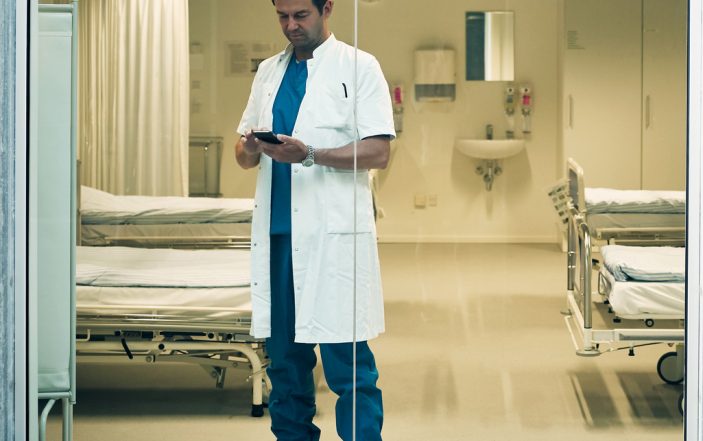Increasingly popular smartphone apps put evidence-based decision support in the clinician’s pocket, but they still can’t replace clinical judgment.
It’s 5:20 a.m. A 35-year-old woman with diabetes and hypertension arrives at your ED complaining of sudden-onset left chest pain waking her from sleep. You know to rule out life-threatening causes of chest pain, but how much should you worry about PE? Are there any new society guidelines on ACS workup? Is a heart rate of 95 considered tachycardic for the PERC Rule, or only for SIRS?
As a resident, I use my smartphone every shift to check medication doses, look up clinical decision rules, or check medication side effects. In a 2012 study of ACGME-accredited training programs, over 68% of residents and 39% of attendings more than 15 years out of training were using medical point-of care-apps.[1]
While younger physicians may adopt this technology more rapidly, usage is not based strictly on age or experience. Now, six years later, these percentages are likely higher due to the introduction of medical apps and technology in training, as well as deeper integration of smartphones in daily life. Medical schools are embracing online references, with some even providing students pre-loaded tablets containing subscriptions to common medical references.
Ninety percent of American medical students surveyed agreed that medical apps enhance clinical knowledge.[2] Beyond general advances and a tech-savvy millennial generation joining the ranks of physicians, another driving force is significant growth in the number and utility of clinical decision scores.
While drug references and e-versions of textbooks have been popular for decades, many clinical decision tools in EM are relatively new. “Traditional” rules in EM – the PERC Rule, Canadian CT Head Rule, etc – are just a couple of decades old. In recent years, the number of rules has grown significantly, and as clinician-researchers continue producing high quality decision rules, we can continue to adapt them for bedside use.
In 2016, Dziadzko identified 176 relevant clinical calculators across all specialties, twice as many calculators compared to 2000.[3] One popular reference, MDCalc, has reported a sharp increase over the last four years, from 80 decision scores to over 360 scores. That represents all specialties, not just emergency medicine.
They report that monthly American physician users are increasing about four-fold as well, from 15% in 2013 with projections over 55% in 2018. Evidence Based Medicine (or EB Medicine), which publishes peer-reviewed evidence-based medicine reviews monthly, recently conducted a survey of residents and attendings from multiple specialties on usage of online medical references. The big winners among both attendings (n = 348) and residents (n = 182) were Medscape, Epocrates, and MDCalc. While the newest to the market, MDCalc was the most used, following the upward trend of clinical scores.
While this research has its limitations – it doesn’t include the very popular UpToDate, and the sample size is small – the data certainly suggest that medical app usage is significant. These numbers can serve another purpose as well, as the starting point for larger discussions of scientific research. They can help integrate statistical probabilities into daily practice.
This is some of the work being done through MDCalc’s educational fellowship program. As an MDCalc Senior Fellow, I have led projects involving rigorously beta-testing new calculators according to MDCalc’s standards and integrating MDCalc links into peer-reviewed publications such as Emergency Medicine Practice. These share the goal of connecting the bench (or clinical research setting) and the bedside through tools like those freely available on MDCalc. And, as nearly every medical journal has an online version, integrating point-of-care tools is a simple, logical way to speed this up.
Never before have there been so many tools at the physician’s fingertips to aid in diagnosis, treatment and education. More importantly, these digital tools are reaching critical mass in terms of usage by practicing clinicians. But that means that new, ever evolving conversations need to be had about knowledge translation and the future of digital medical education. Join the conversation online at www.epmonthly.com.
REFERENCES:
[1] Franko, OI. Tirrell, TF. Smartphone app use among medical providers in ACGME training programs. J Med Syst. 2012 Oct; 36(5): 3135-9. PMID: 22052129.
[2] Quant, C. Altieri, L. Torres, J. Craft, N. The Self-Perception and Usage of Medical Apps amongst Medical Students in the United States: A Cross-Sectional Survey. Int J Telemed Appl. 2016; 2016:3929741. PMID: 27688752.
[3] Dziadzo, MA. Gajic, O. Pickering, BW. Herasevich, V. Clinical calculators in hospital medicine: Availability, classification, and needs. Comput Methods Programs Biomed. 2016 Sep; 133:1-6. PMID 27393794.




